Pop culture collectibles manufacturer Funko (NASDAQ:FNKO) fell short of analysts' expectations in Q1 CY2024, with revenue down 14.4% year on year to $215.7 million. On the other hand, next quarter's outlook exceeded expectations with revenue guided to $232.5 million at the midpoint, or 1% above analysts' estimates. It made a non-GAAP loss of $0.17 per share, improving from its loss of $0.53 per share in the same quarter last year.
Funko (FNKO) Q1 CY2024 Highlights:
- Revenue: $215.7 million vs analyst estimates of $220.3 million (2.1% miss)
- EPS (non-GAAP): -$0.17 vs analyst estimates of -$0.30 (42.4% beat)
- Revenue Guidance for Q2 CY2024 is $232.5 million at the midpoint, above analyst estimates of $230.1 million
- The company reconfirmed its revenue guidance for the full year of $1.08 billion at the midpoint
- Gross Margin (GAAP): 40%, up from 31.6% in the same quarter last year
- Free Cash Flow of $10.35 million, down 65% from the previous quarter
- Market Capitalization: $339.4 million
Boasting partnerships with media franchises like Marvel and One Piece, Funko (NASDAQ:FNKO) is a company specializing in creating and distributing licensed pop culture collectibles.
Funko was born from toy collector Mike Becker's desire to bring back low-tech, whimsically designed toys and collectibles from the past. Over time, Funko evolved from a nostalgia-focused concept to a leading pop culture product company, driven by its mission to connect fans with their favorite pop culture characters and stories.
Funko's core product line comprises collectibles like vinyl figures, bobbleheads, and plush items, underpinned by a wide array of licensing agreements with major entertainment companies. These products cater to the increasing demand for pop culture merchandise, tapping into fans’ desires to own physical representations of their favorite characters.
Revenue for Funko is generated through multiple channels, including specialty retailers, mass-market stores, and direct-to-consumer sales through its website. Its products appeal to a broad spectrum of consumers, from avid collectors and enthusiasts to casual fans.
Toys and Electronics
The toys and electronics industry presents both opportunities and challenges for investors. Established companies often enjoy strong brand recognition and customer loyalty while smaller players can carve out a niche if they develop a viral, hit new product. The downside, however, is that success can be short-lived because the industry is very competitive: the barriers to entry for developing a new toy are low, which can lead to pricing pressures and reduced profit margins, and the rapid pace of technological advancements necessitates continuous product updates, increasing research and development costs, and shortening product life cycles for electronics companies. Furthermore, these players must navigate various regulatory requirements, especially regarding product safety, which can pose operational challenges and potential legal risks.
Sales Growth
Reviewing a company's long-term performance can reveal insights into its business quality. Any business can have short-term success, but a top-tier one sustains growth for years. Funko's annualized revenue growth rate of 8.2% over the last five years was weak for a consumer discretionary business. 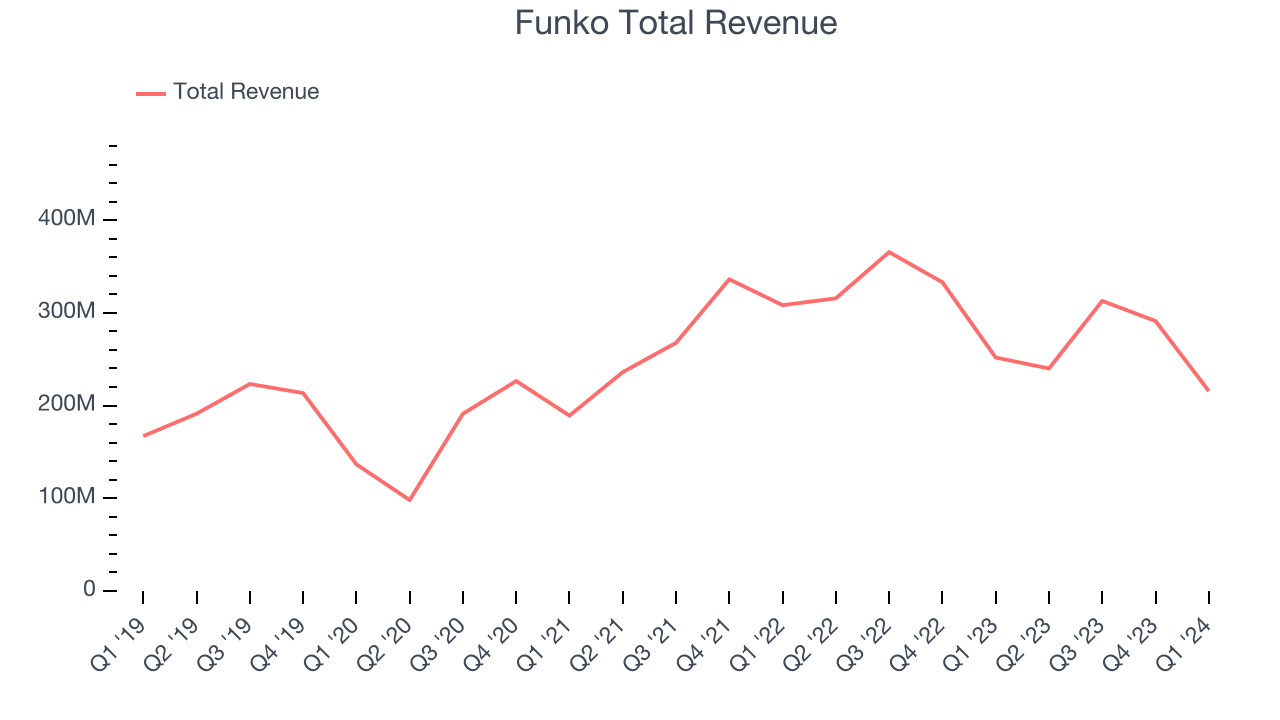 Within consumer discretionary, a long-term historical view may miss a company riding a successful new product or emerging trend. That's why we also follow short-term performance. Funko's recent history shows a reversal from its already weak five-year trend as its revenue has shown annualized declines of 3.9% over the last two years.
Within consumer discretionary, a long-term historical view may miss a company riding a successful new product or emerging trend. That's why we also follow short-term performance. Funko's recent history shows a reversal from its already weak five-year trend as its revenue has shown annualized declines of 3.9% over the last two years.
This quarter, Funko missed Wall Street's estimates and reported a rather uninspiring 14.4% year-on-year revenue decline, generating $215.7 million of revenue. The company is guiding for a 3.1% year-on-year revenue decline next quarter to $232.5 million, an improvement from the 24% year-on-year decrease it recorded in the same quarter last year. Looking ahead, Wall Street expects sales to grow 4.1% over the next 12 months, an acceleration from this quarter.
Operating Margin
Operating margin is an important measure of profitability. It’s the portion of revenue left after accounting for all core expenses–everything from the cost of goods sold to advertising and wages. Operating margin is also useful for comparing profitability across companies with different levels of debt and tax rates because it excludes interest and taxes.
Given the consumer discretionary industry's volatile demand characteristics, unprofitable companies should be scrutinized. Over the last two years, Funko's high expenses have contributed to an average operating margin of negative 6.5%.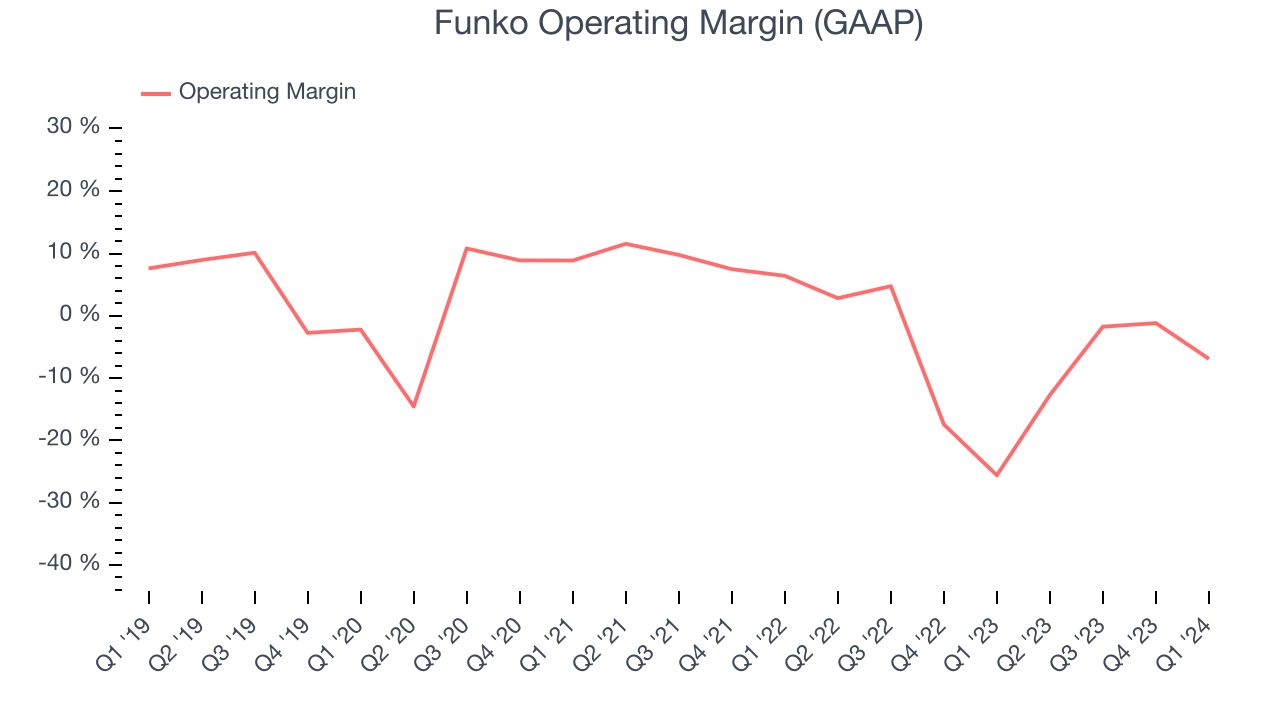
This quarter, Funko generated an operating profit margin of negative 6.9%, up 18.7 percentage points year on year.
Over the next 12 months, Wall Street expects Funko to break even on its operating profits. Analysts are expecting the company’s LTM operating margin of negative 5.1% to rise by 4.8 percentage points.EPS
We track long-term historical earnings per share (EPS) growth for the same reason as long-term revenue growth. Compared to revenue, however, EPS highlights whether a company's growth was profitable. 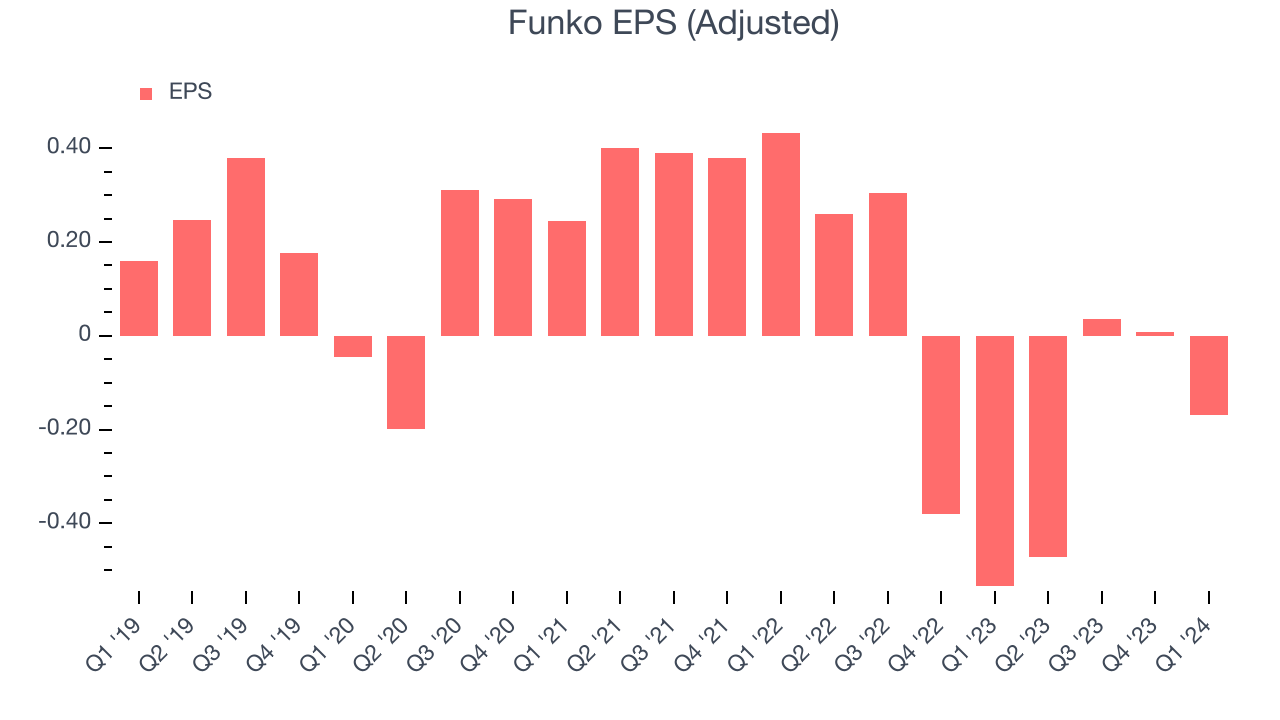
Over the last five years, Funko's EPS dropped 166%, translating into 21.6% annualized declines. We tend to steer our readers away from companies with falling EPS, where diminishing earnings could imply changing secular trends or consumer preferences. Consumer discretionary companies are particularly exposed to this, leaving a low margin of safety around the company (making the stock susceptible to large downward swings).
In Q1, Funko reported EPS at negative $0.17, up from negative $0.53 in the same quarter last year. This print beat analysts' estimates by 42.4%. Over the next 12 months, Wall Street is optimistic. Analysts are projecting Funko's LTM EPS of negative $0.60 to reach break even.
Cash Is King
Although earnings are undoubtedly valuable for assessing company performance, we believe cash is king because you can't use accounting profits to pay the bills.
While Funko posted positive free cash flow this quarter, the broader story hasn't been so clean. Over the last two years, Funko's demanding reinvestments to stay relevant with consumers have drained company resources. Its free cash flow margin has been among the worst in the consumer discretionary sector, averaging negative 2.2%.
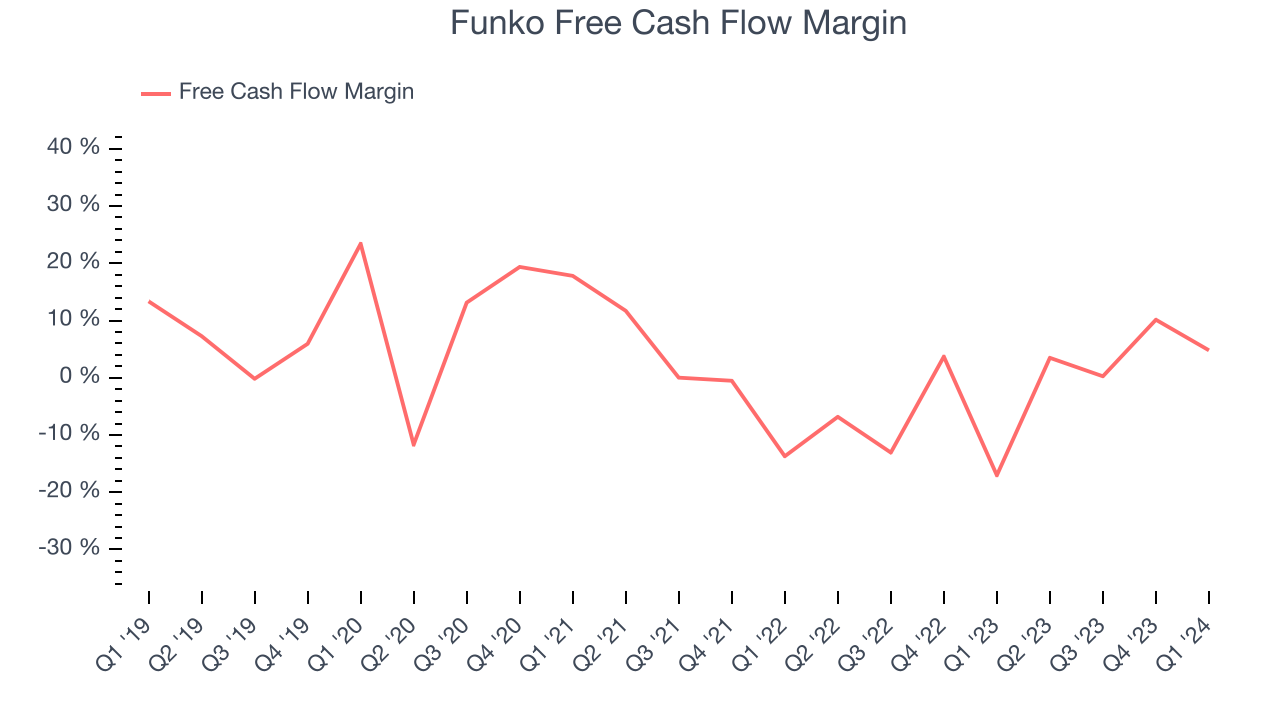
Funko's free cash flow came in at $10.35 million in Q1, equivalent to a 4.8% margin. This result was great for the business as it flipped from cash flow negative in the same quarter last year to cash flow positive this quarter.
Return on Invested Capital (ROIC)
EPS and free cash flow tell us whether a company was profitable while growing revenue. But was it capital-efficient? Enter ROIC, a metric showing how much operating profit a company generates relative to how much money the business raised (debt and equity).
Funko's five-year average return on invested capital was negative 2.3%, meaning management lost money while trying to expand the business. Its returns were among the worst in the consumer discretionary sector.
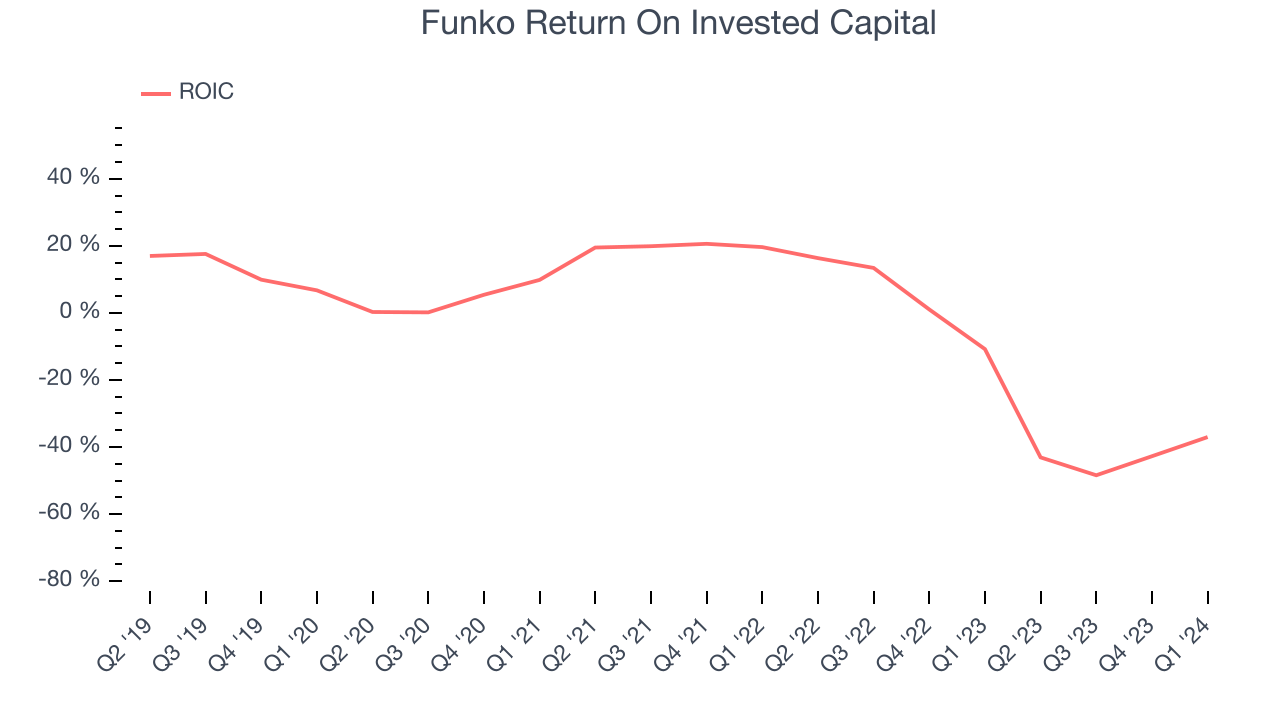
The trend in its ROIC, however, is often what surprises the market and drives the stock price. Unfortunately, Funko's ROIC significantly decreased over the last few years. Paired with its already low returns, these declines suggest the company's profitable business opportunities are few and far between.
Balance Sheet Risk
Debt is a tool that can boost company returns but presents risks if used irresponsibly.
Funko's $330.9 million of debt exceeds the $26.11 million of cash on its balance sheet. Furthermore, its 6x net-debt-to-EBITDA ratio (based on its EBITDA of $50.79 million over the last 12 months) shows the company is overleveraged.
At this level of debt, incremental borrowing becomes increasingly expensive and credit agencies could downgrade the company’s rating if profitability falls. Funko could also be backed into a corner if the market turns unexpectedly – a situation we seek to avoid as investors in high-quality companies.
We hope Funko can improve its balance sheet and remain cautious until it increases its profitability or reduces its debt.
Key Takeaways from Funko's Q1 Results
We were impressed by how significantly Funko blew past analysts' operating margin and EPS expectations this quarter. On the other hand, its revenue missed, but its full-year revenue guidance beat, which is more important to investors. Overall, this quarter's results seemed fairly positive and shareholders should feel optimistic. The stock is up 13.3% after reporting and currently trades at $7.75 per share.
Is Now The Time?
Funko may have had a favorable quarter, but investors should also consider its valuation and business qualities when assessing the investment opportunity.
We cheer for all companies serving consumers, but in the case of Funko, we'll be cheering from the sidelines. Its revenue growth has been a little slower over the last five years, and analysts expect growth to deteriorate from here. And while its projected EPS for the next year implies the company's fundamentals will improve, the downside is its declining EPS over the last five years makes it hard to trust. On top of that, its relatively low ROIC suggests it has historically struggled to find compelling business opportunities.
While we've no doubt one can find things to like about Funko, we think there are better opportunities elsewhere in the market. We don't see many reasons to get involved at the moment.
Wall Street analysts covering the company had a one-year price target of $8.63 per share right before these results (compared to the current share price of $7.75).
To get the best start with StockStory, check out our most recent stock picks, and then sign up for our earnings alerts by adding companies to your watchlist here. We typically have the quarterly earnings results analyzed within seconds of the data being released, and especially for companies reporting pre-market, this often gives investors the chance to react to the results before the market has fully absorbed the information.
